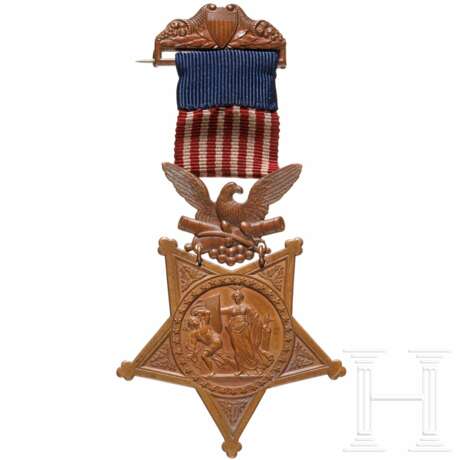Sergeant George Geiger (ca. 1843 - 1904) - Congressional Medal of Honor für seinen Einsatz in der Schlacht am Little Big Horn am 25. Juni 1876
04.11.2024 10:00UTC +01:00
Classic
Sold
6200EUR € 6 200
| Auctioneer | Hermann Historica |
|---|---|
| Event location | Germany, Grasbrunn / München |
| Buyer Premium | 25 % |
Archive
The auction is completed. No bids can be placed anymore.

ID 1325618
Lot 138 | Sergeant George Geiger (ca. 1843 - 1904) - Congressional Medal of Honor für seinen Einsatz in der Schlacht am Little Big Horn am 25. Juni 1876
In Bronze geprägter, auf der Spitze stehender, fünfstrahliger Stern (Army 1. Modell) mit der Stechersignatur "Paquet F.". Die mittels Ringen befestigte Adleragraffe und die Tragespange mit Sicherheitsnadel ebenfalls aus Bronze geprägt. An originalem, leicht verschmutztem Band. Die Rückseite mit der Trägerdedikation "The Congress to Sgt. George Geiger Co. H. 7th U.S. Cav. for Gallantry at Little Big Horn, Mont. June 25 1876". Breite 53,3 mm, Gesamtgewicht 30,97 g.
Die Medal of Honor wurde 1861 als höchste Tapferkeitsauszeichnung durch Präsident Abraham Lincoln während des Sezessionskrieges eingeführt und bis heute in ca. 3.500 Fällen zuerkannt.
Sgt. George Geiger, ca. 1843 in Cincinnati geboren, meldete sich 1861 bei der 47th Ohio Infantry, Comp. A, wurde im Amerikanischen Bürgerkrieg bei Atlanta gefangengenommen und war für zwei Monate im berüchtigen Andersonville Prison inhaftiert. Nach seiner Entlassung 1865 diente er ab 1867 bei der 7th U.S. Cavalry, Comp. M, schrieb sich nur wenige Tage nach seiner Entlassung am 29.11.1872 in Unionville, SC, in Louisville, KY, erneut bei der 7th Cavalry ein und kam in die Comp. H. In der Schlacht am Little Big Horn wurde Geiger mit der MoH ausgezeichnet, als er am 25. Juni 1876 zusammen mit Private Windolph, dem Hufschmied Mechlin und dem Sattler Voit für vier Stunden eine exponierte Stellung außerhalb der eigenen Verteidigungslinie einnahm, um einen Scheinangriff vorzutäuschen, der 15 weiteren Mann ermöglichte, unbemerkt zum Fluss zu gelangen, um das dringend benötigte Wasser insbesondere für die Verwundeten zu holen. Weder Geiger noch seine drei Begleiter noch einer der 15 Kameraden kamen dabei ums Leben.
In der Schlacht am Little Big Horn im Sommer 1876 wurden fünf Kompanien der 7th U.S. Cavalry von Kriegern der Lakota- und Dakota-Sioux, der Arapho und der Cheyenne eingekesselt und in Teilen vernichtet. Von den insgesamt rund 650 US-Soldaten und Scouts fielen 268, darunter George A. Custer wie auch seine Brüder Thomas und Boston, 55 weitere Soldaten wurden verwundet oder vermisst. Auf Seiten der zahlenmäßig weit überlegenen Indianer unter Führung der Häuptlinge Sitting Bull, Gall, Two Moons und Crazy Horse fielen rund 40 Krieger und 80 weitere wurden verwundet.
Sergeant George Geiger (circa 1843 - 1904) – a Congressional Medal of Honor for his action at the Battle of the Little Big Horn on 25 June 1876
Sergeant George Geiger (circa 1843 - 1904) – a Congressional Medal of Honor for his action at the Battle of the Little Big Horn on 25 June 1876
Bronze embossed five-pointed star (Army, first model) with one point facing downwards, bearing the engraver's signature "Paquet F.". The eagle riband buckle fastened with rings and the suspension bar with safety pin, both also embossed in bronze. On the original, slightly soiled ribbon. The reverse featuring the dedication "The Congress to Sgt. George Geiger Co. H. 7th U.S. Cav. for Gallantry at Little Big Horn, Mont. June 25 1876". Width 53.3 mm. Total weight 30.97 g.
Introduced as the highest decoration for valour by President Abraham Lincoln in 1861 during the American Civil War, the Medal of Honor has been awarded to approximately 3,500 soldiers to date.
Sgt. George Geiger, born circa 1843 in Cincinnati, enlisted in the 47th Ohio Infantry, Comp. A in 1861. He was taken prisoner in the American Civil War near Atlanta and detained for two months in the notorious Andersonville Prison. Following his release in 1865, he served with the 7th U.S. Cavalry, Comp. M from 1867, re-enlisted with the 7th Cavalry just a few days after being discharged on 29 November 1872 in Unionville, SC, in Louisville, KY, and was assigned to Comp. H. At the Battle of Little Big Horn, Geiger was awarded the MoH for his bravery on 25 June 1876 in occupying an exposed position for four hours outside their own line of defence, together with Private Windolph, blacksmith Mechlin and saddler Voit. They feigned an attack that allowed 15 other men to make their way unnoticed to the river to fetch the water that was urgently needed, especially for their wounded comrades. Neither Geiger, nor his three companions, nor any of their 15 comrades were killed.
In the Battle of Little Big Horn in the summer of 1876, five companies of the 7th US Cavalry were besieged and partly annihilated by warriors of the Lakota and Dakota Sioux, the Arapho and the Cheyenne. Of the total of about 650 US soldiers and scouts, 268 were killed, including George A. Custer along with his brothers Thomas and Boston, 55 more soldiers were wounded or unaccounted for. On the side of the Indians, who vastly outnumbered them, led by chiefs Sitting Bull, Gall, Two Moons and Crazy Horse, about 40 warriors were killed and 80 more wounded.
Condition: I - II
| Address of auction |
Hermann Historica Bretonischer Ring 3 85630 Grasbrunn / München Germany | ||||||||||||||
|---|---|---|---|---|---|---|---|---|---|---|---|---|---|---|---|
| Preview | |||||||||||||||
| Phone | +49 (0)89 5472 649 0 | ||||||||||||||
| Fax | +49 (0)89 5472 64999 | ||||||||||||||
| Buyer Premium | 25 % | ||||||||||||||
| Conditions of purchase | Conditions of purchase | ||||||||||||||
| Business hours | Business hours
|


